

There were Kitners living in Selworthy from the early 1500s until the mid-18th century and possibly later. Tracing their origins and descendants has been difficult, however, for, with a few exceptions, all the parish registers before 1672 have been lost or destroyed. Moreover, many of the manorial records covering the time of the Civil War and the interregnum were either destroyed or not maintained.
The parish of Selworthy lies to the west of Minehead and close to the Somerset coast, bounded to the south and west by the parishes of Wootton Courtenay and Luccombe. Timberscombe is only a little way to the south, and Porlock a mile or two further west. The parish is divided into two tithings - Allerford and Blackford - and comprises the hamlets of West Lynch, Allerford, Brandy Street, Holnicote, Blackford, Tivington and Tivington Knoll. The road from Minehead to Porlock runs through Allerford, but passes to the south of Selworthy itself.
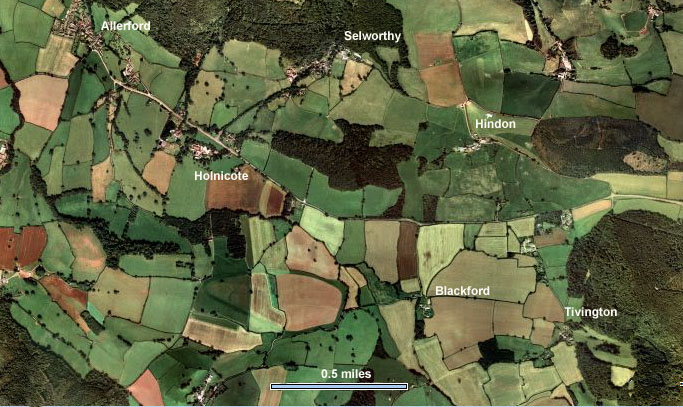
(Microsoft Earth)
At the centre of the parish is the village of Selworthy itself, with its church, rectory, tithe barn (below, left) and glebe lands, and its picturesque limewashed cottages (below, right).
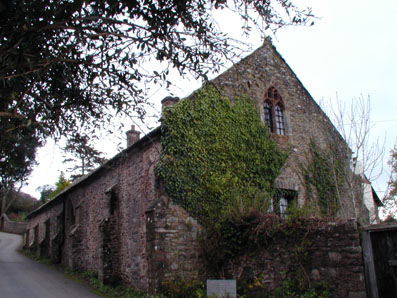
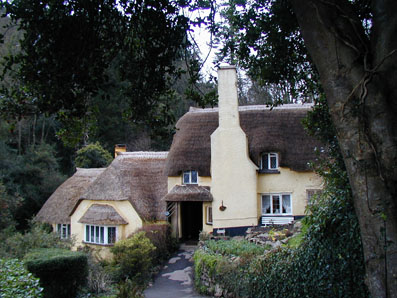
Below, Selworthy from Dunkery Hill, looking north with the Gower Peninsula in the far distance across the 'Severn Sea'.
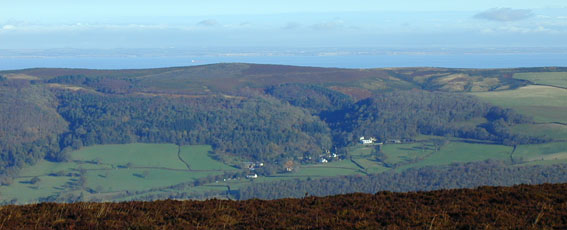
Surviving parish records from before the Civil War (1642-1651) include lay subsidy rolls which list all those who held land leasehold or as sub-tenants and the tax they paid; some lease indentures; estate rent rolls and some individual family papers. But few, if any, of the ordinary craftsmen and farm workers appear in those documents. So such people as can be traced are, generally, only those who held land and paid taxes, and we know little or nothing of families - wives, younger sons and daughters - even of those who were comparatively wealthy.
But the most valuable source - for information on the Kitners - is found in a collection of old documents discovered in the parish chest late in the 19th century. The chest is very ancient and had been neglected for many years, and appears to have been hollowed out from a trunk of elm and bound by a multitude of iron bands. It had three locks, as required by the law, but these were of more recent origin than the trunk itself. Inside the chest was found a very decayed portion of a burials register covering 1571-1579, and a number of deeds concerning property at Allerford which at one time had belonged to Selworthy Church.
The burials register contained two Kitner entries (note 1):
December 1576 - Sidwell ye daughtr of John Kitner was buried ye xiij Daye
July 1578 - John ye son of John Kitner was buried ye xiiij Daye
John Kitner and his wife, probably named Matilda, had another son also named John, born about 1580. The two burials in the register were certainly of children who had died in infancy. In fact there seem to be three generations of John Kitners. The family at this time lived at Tivington where they held property. The eldest John was either a churchwarden or sidesman (assistant to the churchwarden) of Selworthy Church in 1582, and the middle John was churchwarden in 1603 (note 1).
The eldest John is described (in a property document dated 17th March 1582/83) as a clothier - that is a merchant who purchased raw wool from the farmers, arranged its processing and weaving and eventually brought the finished cloth to market. He would have been born probably between 1520 and 1530, and as the family sometimes used the alias Chibbett he or his forebears would have originated from near Exford.
There were Kitners in the Minehead area to the east at an earlier date. John Ketenore paid rent to the Manor of Minehead in 1505 on two tenements and a small area of pasture totalling some 54 acres in the hamlet of Hindon just inside the Minehead parish boundary and only a mile or so from Selworthy. At that time there were five tenements in Hindon totalling some 160 acres; and of these, John held two. However, John Ketenore of Hindon is thought to be of a different line to the Kitners of Selworthy, for a number of reasons: first, the spelling of his name (unchanged from the time of Domesday save for the use of 'K' for 'CH'; second, the absence of any use of the Chibbett alias; and thirdly his will, proved on 8th September 1534, in which he bequeathed cattle or sheep to the churches at Minehead, Selworthy and Wootton Courtenay. The latter suggests a that he may have been related to, perhaps a brother of, Richard Kyttner of Wootton Courtenay (although why is the name spelled differently again?). John of Hindon makes no mention of any relatives in his will and it is possible that the Hindon lease lapsed on his death. We know from manorial records that the two tenements were in new hands by 1603, but we don't know when this transfer took place. (note 2).
There were three lease indentures for land at Allerford in the parish chest in which the name Kitner appears. The first is dated 2nd January 1582/83 and concerns the lease of a tenement in Allerford known as 'Shelve' to a group of young men of the parish, and to "their heirs and assignes for ever". Such a tenement would normally include one or more dwellings, and other farm buildings. The deed provided for the periodic renewal of the lease to a number, limited to ten, of the heirs and successors of the previous tenants, who must also be approved by the then current churchwardens. As so it was. There are records of renewal until the end of the 18th century, when, after over two hundred years, no claim or renewal was made and title was obtained by the last tenants (note 1).
The most valuable part of this indenture lies in the names of those concerned. It is signed by Peter Horne alias Spurrier of West Lynch, Yeoman; John Stoddon the elder of Allerford, husbandman; and John Kitner senior of Tivington, clothier, of "the one partie", representing the church; and "of the other partie" by Edward Pyle of Brandy Street, vitler; Richard Phelps of Selworthy, tanner; Henry, Walter and Thomas Horne the sons of the aforesaid Peter Horne alias Spurrier; John Tayler the son of William Tayler deceased; Edward Kitner the son of John Kitner; Edward Tirrell of Tyvington; John Stoddon the son of John Stoddon the elder, and William Stoddon the younger.
Records of the lease renewal have, generally, not been transcribed, though Hancock (note 2) quotes that of 1623 - probably the third renewal. But we also know the names of the holders of the tenement from two surviving rent lists for the years 1736 and 1745, when the name given to the land had changed from 'Shelve' to 'Overlands'. In 1745 the tenants are John Kent (late Spurrier), Philip Spurrier, widow Hensley (alias Tayler), Andrew Kitner and Richard Tirrell. The inclusion of Andrew Kitner is helpful because it confirms that he was an 'heir or assign' of the original Selworthy Kitners, a fact not established from other sources.
Where was 'Shelve'? I don't know exactly. In the original deed it is described as "lying against the lands of John Arundel esquire of the North Pte and the lands of the heirs of George Harrison of the South Pte, and abutteth on the common highway on both thother ptes within the tithing of Allerford". Hancock (note 1) suggests that it included the old farmhouse adjacent to Allerford Bridge (below, photo by Ian Davey).
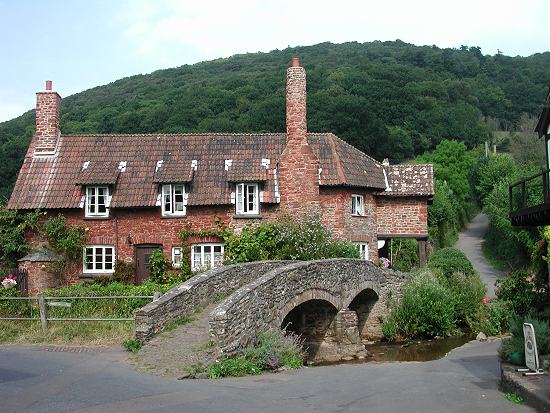
The second of the deeds is dated 25th March 1590, and is between John Elston alias Hooper, John Kitner alias Chebett, John Tailer aHensley, Edward Pile, Lewis Tailer and Edward Rawle alias Yewde, the "four men (ie sidesmen) and churchwardens of the parish of Selworthy of the one partie, and George Sporrier alias Horne, Alice his wife and their son Richard Sporrier of the other". It concerns the lease of a piece of ground known as the Hoppe Yarde. This deed is interesting because it contains the only use of the Chibbett alias by the Selworthy Kitners before the Civil War.
The third deed of interest from the Selworthy Parish Chest is dated 15th October 1623 and is generally similar in form to the first. It is an extension of the lease of 1582/83 and follows the terms of that lease in detail. It is signed by Henry Hyam, Rector; John Phelps and John Kitner representing the parish; by Walter Horne the Elder, Edward Terrill of Dunster and William Stodden, the "surviving Feoffees in trust"; and, for the other part, by the new tenants to whom the lease passes. The John Kitner is almost certainly the one born in 1580, grandson of the eldest John Kitner, clothier, who would have been aged 43 in 1623. He makes his mark instead of signing, indicating that he was illiterate unlike his two forbears. Nevertheless, his signing of the deed indicates that he was probably churchwarden at the time, confirming the association of the family with Selworthy church over three generations.
A further aspect of the third deed is that there is no Kitner among the new tenants. This may be because Edward's wife Sidwell outlived him and is recorded as paying tax at Allerford in 1628, from which we might assume that although not formally acknowledged as a tenant, she was allowed to retain the holding during her lifetime.
Civil War and Commonwealth
For Selworthy the Civil War and Interregnum seems to be a period of almost total disruption. Records are virtually non-existent, and it is extraordinarily difficult to trace any continuity in the Kitner families. In 1641 a Michael Kidner (sic) signed the 'Protestation against Popery' in Selworthy (Chadwyck Healey p.493); and in 1642, Michael was assessed for tax in Allerford. That same year Joan Kidner, widow, was assessed for tax in Tivington. These occurences suggest that Joan was the widow of the younger John (1580-post 1623), and that Michael was their son. Michael may have inherited Edward's share in the Shelve tenement, explaining why he was taxed in Allerford.
The change in spelling from 'Kitner' to 'Kidner' is not material; the change was becoming common throughout West Somerset, and was recorded first at Stogursey and Spaxton around 1550, in Dunster about 1600 and in Porlock by 1620. After the Civil War the change became general although the variants Kitner and Ketnor co-existed and there are still Ketnors living at Luccombe today.
The people of Selworthy, influenced by their rector, were known to be strongly royalist and may have suffered more than most during and after the Civil War. The sequestration of land and property was commonplace and affected the yeoman class most of all: The rich could pay a fine and have their lands restored, while the poor had little worth taking. But evidence of conditions in Selworthy is hard to find. There appears to have been some fighting in the area, for cannon balls have been found in and around Selworthy churchyard.
After 1660 we find only Chibbetts living in Selworthy, and little light can be shed on their condition. There is a list of contributors to a Benevolence granted to Charles II in 1661, but no Kitner or Chibbett is named. It seems that the family had lost much of its wealth and status, and in these straitened circumstances seem to have adopted the Chibbett alias to distance themselves from earlier generations. The antiquarian Thomas Fuller, writing in 1662, records that such changes of name were not uncommon:
"Surnames of families have been frequently altered, some families deposing their old and assuming new names on several occasions; but chiefly...for concealment in times of Civil Wars. A name is a kind of face whereby one is known; wherefore taking a false name is a visard, whereby men disguise themselves...discreetly, in danger, to secure themselves". (note 6)
The first Chibbett entry in the new post-1660 parish registers is in 1676 with the baptism of Elizabeth Chibbett, the daughter of John and Elizabeth Chibbett. Other children follow: Joan in 1678; John in 1682, another Joan in 1686, the first having died in childhood. Two more children followed but their baptisms were held at Luccombe - Thomas in 1692 and Sarah in 1697, indicating that the family moved to Luccombe about 1690.
It seems probable that the John Chibbett who married Elizabeth in Selworthy about 1675 was a direct descendant of the earlier Kitners. There does appear to be a missing generation of which nothing is known, but could John have been a son of Michael Kitner who paid tax in Allerford in 1642?
Notes and sources:
1. F. Hancock, The Parish of Selworthy, 1897
2. F. Hancock, Minehead, 1903
3. C.E.H. Chadwyck Healey, The History of Part of West Somerset, 1901
4. Taunton Wills, BRS Vols XLV and LIII
5. L.F. Gebbett's tables
6. Genealogist's Magazine, Dec 1992, p.152
7. Hancock 1897, pp120,125
Last updated on 21st August 2008